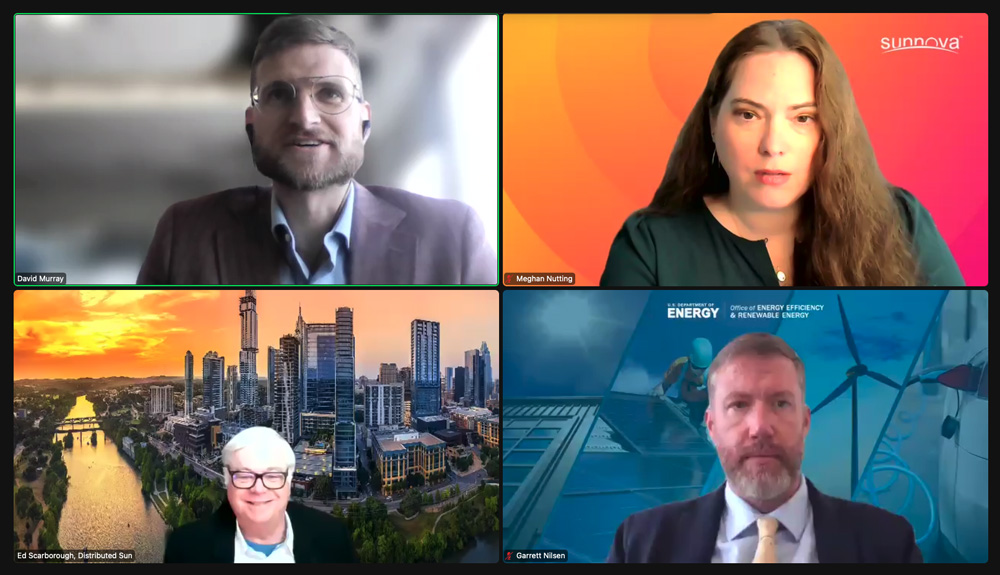PacifiCorp will be able to meet Oregon’s ambitious greenhouse gas emissions-reduction targets for electric utilities, but “it will not be without challenges,” a company official told state regulators Tuesday.
Among those challenges is the sheer growth in PacifiCorp’s projected demand in Oregon, according to Zepure Shahumyan, the utility’s director of energy and environmental policy. The six-state utility expects its Oregon load to increase by 60% by 2030 and 80% by 2040, meaning that growth in absolute emissions will counter progress in reducing per-megawatt-hour emissions.
Shahumyan was among the team of executives on Tuesday presenting PacifiCorp’s integrated resource plan (IRP) and inaugural clean energy plan (CEP) to members of Oregon’s Public Utility Commission, launching the utility’s 2023 IRP process.
PUC Chair Megan Decker noted that it will be the first time the commission will be considering a CEP within an IRP proceeding. CEPs are a new requirement for Oregon utilities, the product of House Bill 2021, which state lawmakers passed two years ago to require electricity providers to reduce their GHG emissions to 80% below a 2010-2012 baseline by 2030, on the path to zero emissions by 2040.
For PacifiCorp, that will mean cutting emissions to 1.8 million metric tons (MMT) of CO2 equivalent by 2030 from a baseline of 8.9 MMT — and from actual current levels of about 11 MMT. HB 2021 also requires the utility to achieve another reduction to 0.9 MMT in 2035 ahead of the 2040 zero-emissions mandate.
Randy Baker, PacifiCorp’s director of resource planning, told the PUC that the 2023 IRP positions the utility to hit those targets. Over the next 20 years, Baker said, PacifiCorp seeks to add 9,111 MW of new wind generation, 8,095 MW of storage resources and 7,855 MW of new solar.
To support that growth in renewables and tap resources located farther inland, the utility also seeks to add more than 1,000 miles of new transmission, including the proposed Boardman-to-Hemingway (B2H) project, to be built in partnership with Idaho Power. Part of the PacifiCorp’s Energy Gateway project designed to increase flows between the company’s eastern and western systems, the 500-kV B2H line would run for 290 miles from the Boardman substation in Eastern Oregon to the Hemingway substation in Idaho, with additional links expected to grow out from both ends, Baker said.
PacifiCorp’s IRP additionally calls for 4,953 MW in capacity savings through energy-efficiency programs and 929 MW saved through demand response.
The PacifiCorp officials presenting Tuesday also acknowledged that meeting the 2040 zero-emission requirement will require adoption of technologies still under development, including 1,500 MW of advanced nuclear generation and 1,240 MW of non-emitting peaking resources. The utility in 2021 agreed to partner with Washington-based TerraPower to build a demonstration Natrium small reactor at the site of a retiring coal plant in Wyoming and last year said it would explore deploying five such plants in its service territory by 2035.
Baker also pointed out that HB 2021 requires that small-scale renewables make up 10% of PacifiCorp’s resource portfolio by 2030. Those resources currently comprise 4.6%, leaving PacifiCorp to procure an additional 490 MW by the target year. He told the commission that PacifiCorp has not received as many bids for small-scale projects as it would have liked, and he encouraged developers “to begin the process to identify interconnection costs for projects” ahead of the opening of a request for proposals in April 2024.
‘Massive Load Increase’
But the prospect of sharp load growth in Oregon will complicate the way PacifiCorp complies with state emissions targets.
Commissioner Mark Thompson noted that the projected 60% jump in demand by 2030 represents “just a massive load increase in a very short time” and asked what the utility could publicly divulge about the nature of the new load.
“I can’t speak much about the load, but I can say it’s a large new commercial load that we are forecasting and as part of the planning horizon and planning assumptions for load on our system and in Oregon specifically,” Shahumyan said.
As a result, she said, PacifiCorp will likely need to bring on even more small-scale renewables — beyond the HB 2021 requirement — to prevent serving that load with other emitting resources in the utility’s six-state system, which also includes portions of California, Idaho, Utah, Washington and Wyoming.
PacifiCorp’s efforts will be further complicated by ongoing changes to its resource mix, part of its push to reduce companywide GHG emissions and reach net zero by 2050. While the utility’s IRP calls for retiring much of its coal fleet in the coming years, it plans to convert a handful of coal-fired units to natural gas and operate them until the middle of the next decade. It also plans to upgrade NOx emissions-reduction equipment at its Hunter and Huntington coal plants in Utah and keep those facilities running until 2042.
All those plants will have to play a diminishing role in providing energy to Oregon because, as Shahumyan pointed out, they will continue to contribute to emissions. But those units will still be part of a PacifiCorp system designed to allocate the costs and benefits of all resources across participating states in a process administered by utility regulators.
To overcome the challenges of meeting Oregon’s mandate, PacifiCorp has identified two “pathways,” which Shahumyan said are not mutually exclusive.
The first pathway entails managing how gas-fired resources are dispatched until they are replaced by non-emitting peaking technologies.
“Since adding renewables doesn’t inherently reduce your emissions, you have to back off thermal emission drivers in order for them to impact our goals under HB 2021,” Shahumyan said. “So just flooding the system with renewables by itself won’t do it.”
The second pathway will require PacifiCorp to engage in multistate negotiations with regulators on how to allocate the costs and benefits of its systemwide resources.
“Under this pathway, we’re still allocating our system to Oregon, but we’re limiting thermal resource allocation to Oregon,” Shahumyan said. By doing that, she noted, the utility reaches its 90% emissions reduction target by 2033, seven years ahead of deadline.
During a public comment period after the PacifiCorp presentation, Mike Goetz, general counsel with the Oregon Citizens’ Utility Board, urged the utility to revise its IRP to replace coal with renewables — not new natural gas units.
“Has PacifiCorp truly put forward a least-cost, least-risk plan to benefit Oregon customers while complying with applicable mandates? Or is it simply planning as a system and then layering on HB 2021 requirements?” Goetz said. “On top of that, if PacifiCorp continues to operate thermal units across its system by converting a number of coal plants to gas, how will the cost of these resources be allocated in future years?”
The Oregon PUC is now taking comment on PacifiCorp’s IRP and CEP and will hold another public meeting on the plans Aug. 10.

